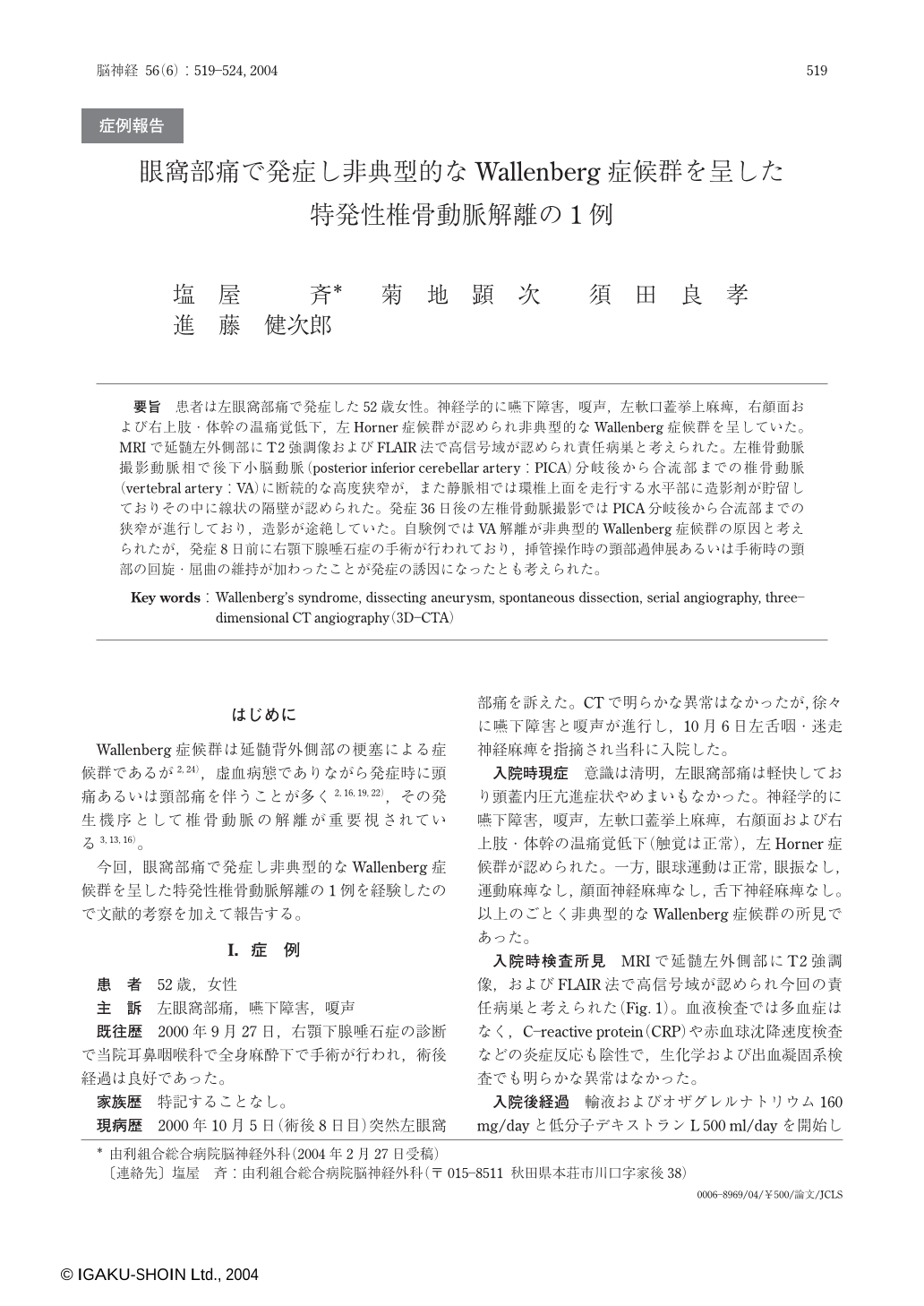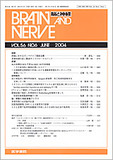Japanese
English
- 有料閲覧
- Abstract 文献概要
- 1ページ目 Look Inside
要旨 患者は左眼窩部痛で発症した52歳女性。神経学的に嚥下障害,嗄声,左軟口蓋挙上麻痺,右顔面および右上肢・体幹の温痛覚低下,左Horner症候群が認められ非典型的なWallenberg症候群を呈していた。MRIで延髄左外側部にT2強調像およびFLAIR法で高信号域が認められ責任病巣と考えられた。左椎骨動脈撮影動脈相で後下小脳動脈(posterior inferior cerebellar artery:PICA)分岐後から合流部までの椎骨動脈(vertebral artery:VA)に断続的な高度狭窄が,また静脈相では環椎上面を走行する水平部に造影剤が貯留しておりその中に線状の隔壁が認められた。発症36日後の左椎骨動脈撮影ではPICA分岐後から合流部までの狭窄が進行しており,造影が途絶していた。自験例ではVA解離が非典型的Wallenberg症候群の原因と考えられたが,発症8日前に右顎下腺唾石症の手術が行われており,挿管操作時の頸部過伸展あるいは手術時の頸部の回旋・屈曲の維持が加わったことが発症の誘因になったとも考えられた。
We report here a case of atypical Wallenberg's syndrome due to spontaneous vertebral artery(VA) dissection.
A 52-year-old woman was admitted to our department because of a sudden onset of left orbital pain. Emergency CT scan disclosed no evidence of intracranial hemorrhage. Neurological examination at the time of the current admission, showed dysphagia, left soft palate palsy, hoarseness, left Horner syndrome, hypalgesia with thermohypesthesia on the right side of her face, however, hypalgesia with thermohypesthesia on the right side of her body. The diagnosis of atypical Wallenberg's syndrome was based on the above findings. MR images disclosed the infarcted lesion at the left lateral medulla depicted as high-intensity on T2-weighted & FLAIR images. We carried out conservative treatment with antiplatelet & hemodilution therapies and the blood pressure control.
Left vertebral angiograms obtained 18 days after the onset, showed the segmental severe stenosis of the VA between the ramification of the posterior inferior cerebellar artery(PICA) and the union of the VAs. In the venous phase, retention of contrast medium in the VA and the PICA was observed. The flow rate of the parent artery was decreased. We strongly suspected that her initial symptom of left orbital pain was due to dissection of the VA itself. Three-dimensional CT angiograms obtained 30 days after the onset, demonstrated the defect of the left VA between the ramification of the left PICA and the union of the VAs.
Left vertebral angiograms obtained 36 days after the onset, showed the occlusion of the VA between the ramification of the PICA and the union of the VAs. The neurological findings gradually improved and the patient was discharged. Follow up left vertebral angiograms obtained 4 months & 16 months after the onset, revealed almost no changes of left VA occlusion.
(Received : February 27, 2004)

Copyright © 2004, Igaku-Shoin Ltd. All rights reserved.


